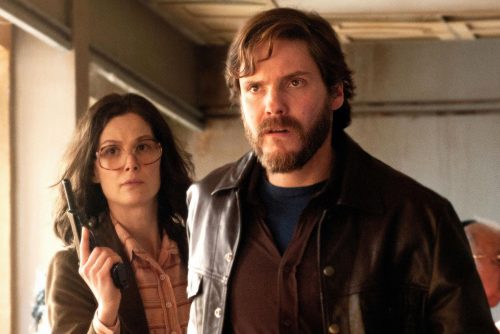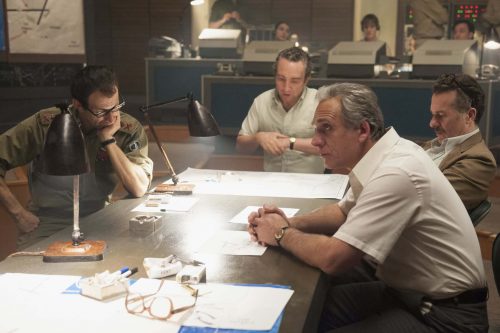“7 Days in Entebbe” is based on the real-life, breathtaking story of 1976’s Operation Thunderbolt, when Israeli commandos flew 2,000 miles to Entebbe, Uganda, to rescue 100 Jewish hostages held by two German terrorists and several members of the PFLP (Popular Front for the Liberation of Palestine). It’s a story so compelling it’s already been adapted into several films of varying quality, but since it’s 2018 it was clearly time for someone to make a bad reboot.
The ostensible protagonists of this film are not the hostages, nor the Israeli commandos who pulled off this incredible rescue. Instead, the story focuses on the two noob German revolutionaries, Böse (Daniel Brühl) and Brigitte (Rosamund Pike), who hijack an Air France plane full of Israeli and French passengers and take it to Uganda. Brühl (stuck playing a less compelling variant of his character Zemo from “Captain America: Civil War”) and Pike are solid actors, but director José Padilha uses some pretty bald symbolism to show how human they are and how sympathetic we should feel toward them. As my colleague Zach said: “The two main characters are developed as your next-door social justice warriors. They’re intellectuals. They’ve read all the books and attended all the protests. They want to change the world, and it’s time to act. They are real, human, relatable and vulnerable. Meanwhile, the Israelis, hostages and politicians are shells with no moral compass, seemingly driven by only political power.”

Böse, for example, is represented as so wishy-washy about this whole terrorist thing that in his establishing shot in the film, and in many subsequent scenes, he’s shown standing next to a dripping sink (#metaphors). Brigitte’s internal struggle is illustrated by repeated shots of her popping unidentified blue pills, and a scene shortly before the rescue, and her death, where she cuts off all her hair (#symbolism).
Shimon Peres (Eddie Marsan) and Yitzhak Rabin (Lior Ashkenazi) are merely side characters in the film. Peres is pretty fun in this, but I could have done with fewer close-ups of Marsan’s unfortunate eyebrow weave. Said my colleague Aviva: “I enjoyed watching the Israeli political characters in the movie, particularly a young Shimon Peres, who is adamant that Israel must take action to rescue the hostages. And, you know, it was a fun flashback to 1970s eyeglass fashion.”

The tension in Israel over the hijacking and rescue is indicated in the film by clouds of cigarette smoke. I lost count of how many scenes featured Rabin stamping out a half-finished cigarette while Peres smirks at him across the table. In all seriousness, though, Aviva added that “the operation sent the message that Israel isn’t just a homeland for those living in its borders—it exists to safeguard the wellbeing of Jews around the world, and it’s an incredible story that should be shared with the world.” The film’s creators, however, “took significant liberties in presenting Israel’s political situation—both past and present.”
There are so many perplexities to go around. (As Zach said afterward, “At first, I was just confused, underwhelmed and emotionally distraught.”) Inexplicably, Padilha chose to intercut the film with a modern dance piece by choreographer Ohad Naharin, performed by the Batsheva Dance Company. Not only does the performance begin the film, but Padilha cuts to repetitions of the piece ad nauseam throughout the whole film, including the action sequence of the rescue itself. This use of the dance bits is bewildering and evoked several giggle fits from me during the most high-tension, dramatic part of the film. It’s like if Christopher Nolan decided that what “Dunkirk” really needed was less air, sea and land battles and more dance battles from “Step Up 2: The Streets.” When the hostages are successfully rescued, the film cuts to the audience applauding the dance company…almost like a parallel to how the world was an audience to the rescue. Wow. Such symbolism! Much metaphor!

The only tenuous connection between the dance company scenes and the actual plot is the character of Sarah, a dancer in the troupe who is the girlfriend of one of the commandos. The soldier in question, Ziv, is a composite character who mainly exists to take screen time from actual real-life commandos like Yoni Netanyahu, who barely has any lines in the film at all.
The film ends with yet another dance performance, this one featuring a woman running in place, face toward a wall, going nowhere. I imagine this sequence is intended to represent the stalling of the peace process. Or, perhaps, it symbolizes the entire pointlessness of going to see this film in the first place. As Zach so elegantly concluded, “Any remake of a film that already had a remake that starred Chuck Norris is going to be really, really bad. I recommend the 1986 cinematic sensation ‘The Delta Force,’ a genre-defining movie and epic masterpiece based on the same true story, only Chuck Norris’s fist replaces the entire IDF. I prefer that slight inaccuracy to the artistic liberties of ‘7 Days in Entebbe.’”



